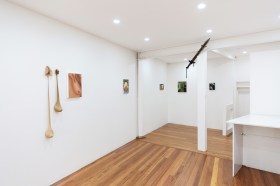Whether you are an artist sending artworks to a gallery for potential sale or exhibition, or you are a craftsperson or maker placing production work at a shop or a gallery, you need to protect yourself with a Consignment Agreement.
These need not be complicated documents. But they should outline the terms of the agreement – from the length of time, expectations around payment and commission, and care and handling of your work – so both parties are on the same page.
WHY YOU NEED A CONSIGNMENT NOTE
In a nutshell, a Consignment Agreement will help protect the commercial relationship between you (the supplier or the Consignor) and another business (the Consignee). And regardless of what great chums you might be – money is involved – so you have to be clear and professional from the start of that relationship.
An agreement will reduce liability and clearly outline expectations of that relationship.
The other reason you need a Consignment Agreement is because you remain the owner of your goods until your Consignee sells them onto a customer. So you have to ensure they are protected, and it also means you can request that your goods be returned to you at any point during the commercial relationship.
WHAT IT SHOULD INCLUDE
If you are drafting your own Consignment Agreement there are few simple details you need to include:
- Parties: It is really important to date the agreement and for both parties to sign a copy.
- Ownership: First it must be stated that you remain the owner of the objects until they are purchased, and have the right to request their return should any terms of the agreement be broken, or other circumstances arise with fair consideration.
- Duration: You need to ascertain the duration of the consignment. If the stock is in high demand you may want to keep it to six months. A standard agreement could cover 12-months, with an updated consignment issued thereafter.
- Items: Clearly list what is being consigned – titles, dimensions, colour (sometimes needed with product), inventory numbers – and quantity.
- Payment: Outline payment agreement – what is the wholesale and/or RRP price; what is the commission agreed upon with the agent, The contract should state how long the consignee has to make payment to the consignor. The agreement could also give the consignee the right to discount the item’s price with or without the consignor’s approval.
- Right of Return: You should also consider a clause about the return of product or artworks. This allows the opportunity to refresh inventory, and also if stock is not moving, the ability to place it elsewhere.
- Shipping: With regard to the return of goods, you need to discuss with the agent who pays for the freight. In most cases you are responsible for getting it to them; and them returning it to you – but this is negotiable. Be clear up front as this can be an added cost to you.
- Damage: You need to address what happens is the artwork or product is damaged while in the care of the agent. The consignee is usually required to carry insurance that will cover the consigned item.
- Marketing: An option is to also include a clause that the gallery / shop / agent has the right to use images of your work for marketing purposes, with correct creditation.
- Termination:The agreement discusses how the contract can be terminated, such as by a certain date if the item is unsold, or if the consignee goes bankrupt, leaves the area, dies, or if the consignor dies.
There are many of these pro forma documents that can be downloaded from the Internet, but be careful because it’s better to use a template based on Australian law.
Alternatively you can turn to organisations such as the Arts Law Centre of Australia, which has downloadable templates.
What to do if the Consignee is not complying to the agreement
We all want to get paid for our work – it’s a no brainer. But even with the most well-laid Consignment Agreement in place, some galleries and retail outlets don’t pay.
First point is to do your research to ensure that you are entering a partnership with an ethical and financially liquid business.
The fact that you have an agreement in place, arms you with a chance of getting your money.
Take for example Aboriginal artist, weaver and basket maker, Micky Barlow. Arts Law supported her when eleven of her works were sold from an exhibition, but the gallery failed to pay. Despite following up personally, she was getting nowhere.
Arts Law advised Barlow to send a Letter of Demand to the gallery. Arts Law explained: ‘A letter of demand serves two purposes. First, it warns the debtor of your intention to commence legal proceedings unless payment is made and gives the debtor one more opportunity to pay.
‘Secondly, the letter is a document which may be tendered in evidence during court proceedings as written proof of your claim of the debt owed and your attempt to settle the matter. Micky was successful in ultimately obtaining payment in full from the gallery.’
It worked, and Barlow was returned the owing funds.
Check out Arts Law’s template Letter of Demand for Debt Recovery and Micky’s case study.
PROTECTING YOUR SELF AGAINST CONSIGNEE BANKRUPTCY
Arts Law negotiated a similar case for Ninuku Arts – an Indigenous owned art centre located in the remote APY Lands in South Australia.
‘…It entered into a consignment agreement with an Adelaide gallery for the sale of 29 artworks by 19 of its artists. There was no written contract merely an itemised list of the paintings signed by the gallery. There was no clear agreement about how and when the sale proceeds would be paid,’ explained Arts Law.
While payment was made for the majority of works sold, six payments remained outstanding. Artists in the Black (Arts Law) sent a formal letter of demand on behalf of Ninuku Arts to the gallery, but received no response.
‘Artists in the Black turned to its long-time supporters DLA Phillips Fox in Adelaide (now Fox Tucker Lawyers) for pro bono assistance. Another letter of demand was sent and the gallery owner finally responded,’ explained Arts Law.
A settle was negotiated, with the gallerist paying the outstanding amount in monthly instalments. ‘The debtor simply could not pay the full amount but was prepared to pay instalments,’ Arts Law added.
You can read about these cases and others via Arts Law.
Arts Law says that it demonstrates how these simple documents – a Consignment Agreement and a Letter of Demand – can offer a legal path to protect your professional position … and your pocket.
All said, Arts Law makes the point that having a written consignment agreement is not a guarantee that the work will be returned if the gallery goes bankrupt or into liquidation.
‘The law was changed in 2012 requiring consignments to be registered under the Personal Property Securities Register (PPSR) in order for the artwork not to be treated as an asset of the business and sold off to meet the business’ debts …an artist should consider registering the consignment with PPSR to ensure they can get their artwork back,’ explained Arts Law.
Arts Law can provide advice about this or you can listen to their podcasts on consignments and the PPSR.






